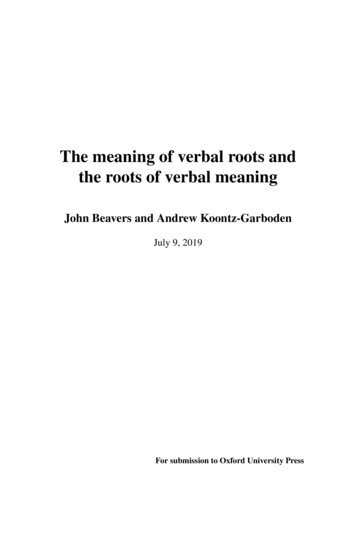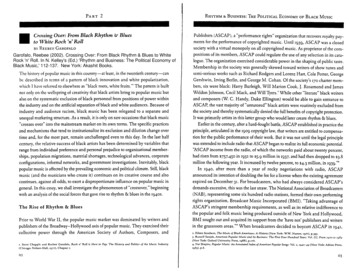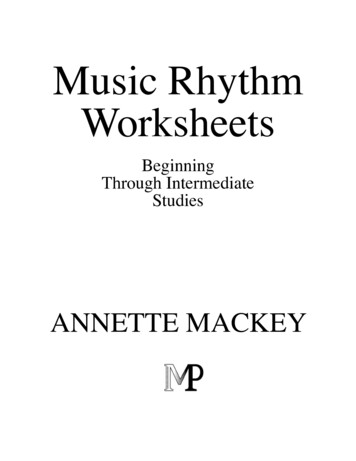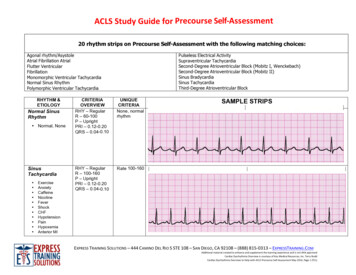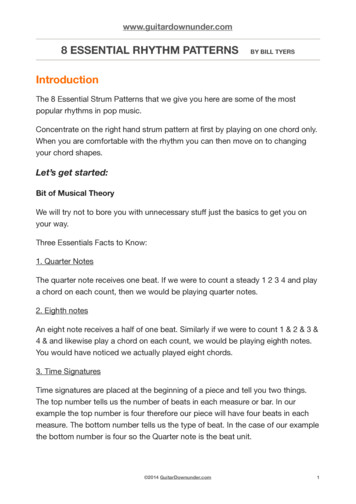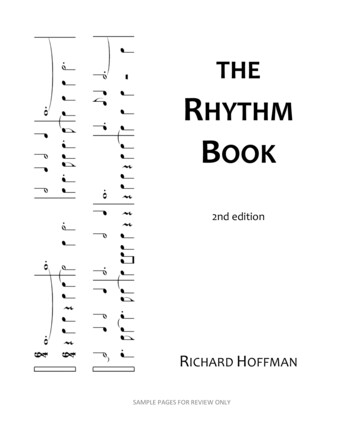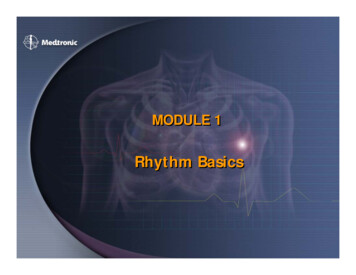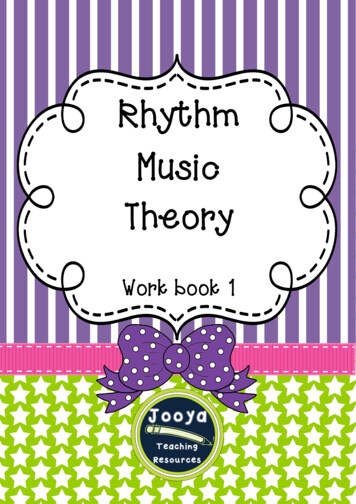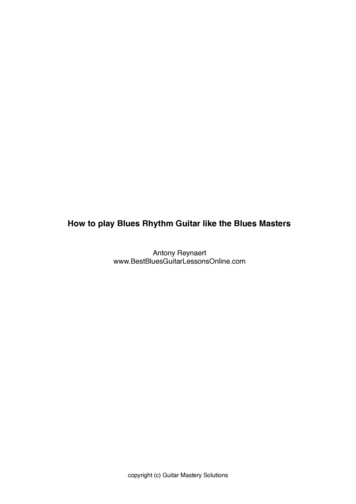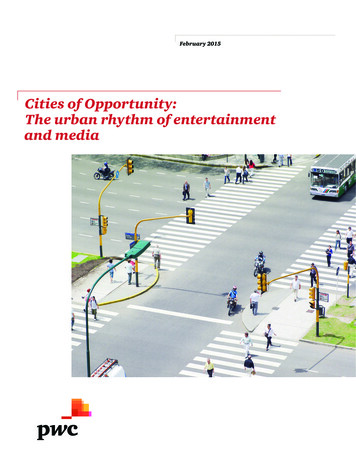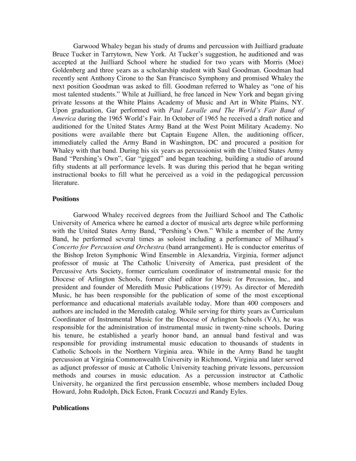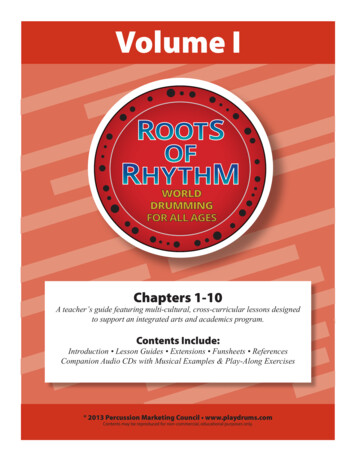
Transcription
Volume IChapters 1-10A teacher’s guide featuring multi-cultural, cross-curricular lessons designedto support an integrated arts and academics program.Contents Include:Introduction Lesson Guides Extensions Funsheets ReferencesCompanion Audio CDs with Musical Examples & Play-Along Exercises 2013 Percussion Marketing Council www.playdrums.comContents may be reproduced for non-commercial, educational purposes only.
Roots of RhythmWorld Drumming for All AgesVolume ITable of ContentsPageAcknowledgements. 3About the Author. 4Welcome!a. Welcome from the International House of Blues Foundation (IHOBF) and thePercussion Marketing Council (PMC) . 5b. The Benefits of Studying the Roots of Rhythm. 6Introductiona. Introduction to Roots of Rhythm Lessons. 7b. Charts for Roots of Rhythm Instruments and Cultures . 9c. Lesson Format. 9d. Making Your Own Instruments .12Volume IRoots of Rhythm: Chapters 1-101. The Adufe, a rattle drum from Portugal.152. The Bongos, a drum set from Cuba .233. The Buhai, a friction drum from Romania .314. The Djembé, a goblet drum from Guinea.395. The Dondo, an hourglass drum from Ghana .476. The Kakko, a barrel drum from Japan .557. The Lakota Drum, a frame drum from North America.638. The Naqqāra, kettledrums from Turkey .719. The Ranāt Ēk, a xylophone from Thailand.7910. The Sājāt, cymbals from Egypt .87Companion CD Notes & Contacts.95References .102Funsheet Notes and Answers .109Program Evaluation Form.113TUBS Notation Blank Pages.1151
2
Roots of Rhythm: Volume IWorld Drumming for All AgesAcknowledgementsThe Roots of Rhythm: Volume I includes Roots of Rhythm chapters 1-10, References, Funsheetsand Companion CD Notes. The following people contributed to the development of theoriginal and subsequent parts of the Roots of Rhythm curriculum: David Levine of thePercussion Marketing Council; Eric Jarvis, Susan Jauron and Susan Park-Ryoo of theInternational House of Blues Foundation; and Dr. Craig Woodson of Ethnomusic, Inc.,author of the teacher's guides and CDs.Additionally, the following people contributed immensely to this educational resource throughinterviews: Aisha Ali, Francis Awe, Ace Boogie, Dennis Delucia, Chalo Eduardo, Cenk Ergun,Jeff Fiedler, Dr. Robert Garfias, Dr. Charlotte Heth, Souhail Kaspar, Abhiman Kaushal, KevinLocke, Walt Mahovlich, Olugbala Manns, Dr. Terry Miller, Leon Mobley, Johnny Mori andBenjamim Pereira, Ann Briegleb Schuursma and Robin VanLear.Several people and the organizations that they represent supported the development of Roots ofRhythm: Gonçalo Luís Ramos de Oliveira with the Associação Pédexumbo, Julian Parnabywith Celestial Harmonies, Dr. Daniel Sheehy, Richard Burgess, and Brian Andersonwith Smithsonian Folkways, Yasuhiro Kakigahara with Tokyo Concerts, Inc., and Dr.Jacqueline DjeDje and John Vallier of the Ethnomusicology Archive and Dr. Ali Jihad Racy,Dr. Timothy Rice, and Donna Armstrong with the University of California at Los Angeles.The following persons/organizations graciously donated or licensed traditional tracks to theRoots of Rhythm Companion CD: ARC Music International, Aisha Ali/Disks Araf, CelestialHarmonies, Dr. Terry Miller/The Center for the Study of World Musics, Leon Mobley,Smithsonian Folkways & the Center for Folklife Programs and Cultural Studies atthe Smithsonian Institution, and the UCLA Ethnomusicology Archive.Finally, Tommy Wiggins worked tirelessly as recording engineer on the Roots of RhythmCompanion CD, and thanks goes to Sara and Theo Woodson, who assisted with many of thephotographs.3
About the Author of Roots of Rhythm: Volumes I and IIDr. Craig Woodson earned his doctorate in music from the University of California at LosAngeles, with specializations in music education, ethnomusicology, and ethnic musicalinstrument technology. He has been a percussion teacher, a performing and recording musician,college lecturer, a teaching artist in schools, and a music consultant for over 35 years. He haswritten articles and performed in videos on musical instruments, drumming, and the making ofsimple musical instruments from around the world.After starting a small business making ethnic musical instruments in the 1970s he obtainedtwelve U.S. patents on musical instrument technology. In 1979, he started a three-year project asan invited researcher in Ghana, West Africa, assisting in the mass production of Africaninstruments for Ghanaian schools. His writing includes computer transcriptions of jazz drummer,Tony Williams’ solos and African drumming and drum making.He has been a music consultant to Walt E. Disney Enterprises, the U.S. State Department, Remo,Inc., and the Percussion Marketing Council. Dr. Woodson has presented educational concertswith organizations such as The National Symphony Orchestra, the Los Angeles Philharmonic,the Cleveland Orchestra and Kronos Quartet. In 2000, he was featured in a NASA video onmusic and space science, and was given a grant from the National Endowment for the Arts foreducational programming.Dr. Woodson has played drums in movies with Elvis Presley, performed on TV with LindaRonstadt, and recorded with Ray Manzarek of the Doors. As a Columbia recording artist in 1968he was a member of the celebrated electronic rock band, the United States of America. He was aconsultant and Senior Director of Education at the Rock and Roll Hall of Fame and Museum.From 2005 to 2013, he received support from the International Music Products Association(NAMM) and the NAMM Foundation through the Percussion Marketing Council to write andteach the Roots of Rhythm. Beginning in 2009, Dr. Woodson became Director of Roots ofRhythm, and has continued to teach RoR workshops around the United States and overseas.In 2009-2010 Dr. Woodson traveled to Iraq and Indonesia for humanitarian work with a musictherapist. At that time he started his non-profit, Drums of Humanity to assist with this effort. Hiswork is recognized by an agency of the United Nations in the compendium, Music as a NaturalResource. He continues to work a teaching artist, performing musician, world music consultant,and writer. He has two grown children and lives in Chagrin Falls, Ohio.4
Roots of Rhythm: Volume IWorld Drumming for All AgesWelcome!Roots of Rhythm: World Drumming for All Ages takes teachers and students on a journey toexplore different cultures, music and instruments from around the world and enjoy bothlistening to and playing rhythms using ethnically diverse percussive instruments, found orstudent-made instruments, or body percussion. Roots of Rhythm is the result ofcollaboration between the Percussion Marketing Council and the International House of BluesFoundation (IHOBF) and was created for use in IHOBF and other arts and educational programs.The curriculum, which combines music with history, social studies, geography and languagearts, has been designed to support classroom teachers in integrating music, music-makingactivities and related cultural content into classroom curriculums. Content and activitiesalign with state and national education standards.Roots of Rhythm offers teachers and students an enjoyable and educational experience and canserve as a point of departure for exploring other rhythms and cultures, past and present, fromaround the world. By supporting music experiences outside of the music room and bringingthem into the regular classroom, Roots of Rhythm creates opportunities for many more studentsto learn about music and participate in music-making activities.The IHOBF is dedicated to bringing the arts to schools and communitiesthrough programs that promote cultural understanding and encourage creativeexpression. IHOBF was established in 1993 and has expanded to sevenlocations nationwide, including Anaheim, Chicago, Cleveland, Las Vegas, LosAngeles, New Orleans and Orlando. IHOBF programs teach about Americanculture and history through blues music and folk art, encourage exploration andappreciation of diverse cultures, emphasize the importance of creative expression and supportyouth participation in the arts. Core programs include the Blues SchoolHouse, Make AnImpression, Visiting Artist programs, and Blues Ambassador Scholarships. Each IHOBFlocation also hosts an annual Dr. Martin Luther King, Jr. program and participates in localcommunity cultural activities. Programs are offered at House of Blues venues as well as inschool and community settings. To learn more about IHOBF mission and programs visithttp://www.ihobf.org.Formed in 1995, the Percussion Marketing Council is a trade organizationmade up of drum and percussion manufacturers, suppliers and dealers. It isgoverned by a board made up of a representative group of its members. ThePMC's goals are two-fold: 1) to expand the drum and percussion market byincreasing the public visibility of all forms of drumming and by promoting5
drums and drumming as a positive, healthy activity for all members of the public through avariety of activities; 2) to unify the percussion industry by providing a forum for intra-industrycommunication. In order to achieve the above goals, the PMC relies on funding in the form ofannual membership dues as well as financial contributions from music-related companies andorganizations.How Teachers and Students Benefit from Roots of RhythmTeachers: Learn about rhythms, drums and percussive instruments from around the world within theirrespective cultural and historical contexts. Gain ideas and resource materials for use in introducing Roots of Rhythm content intoclassroom curriculums.Students: Learn about different countries and cultures (basic geography, social history, cultural andmusical traditions). Gain awareness of how music reflects life conditions and experiences. Increase their understanding of different cultural traditions and belief systems and of howdiverse cultures influence one another. Learn names of and sounds made by different drums and other percussive instruments. Learn about rhythms and musical styles from different cultures. Learn to play and create rhythms. Develop listening skills and music appreciation. Have fun listening to and making music.6
Roots of Rhythm: Volumes I & IIWorld Drumming for All AgesIntroduction to Roots of RhythmRoots of Rhythm: World Drumming for All Ages is a curriculum that introduces tenpercussion rhythms from around the world to teachers through chapters that place a specificinstrument and its rhythm in the context of a particular country and culture. Each chapterbegins with information about the country’s flag, size, population, geography and climate.This is followed by a description of the country’s background, history, and culture. The lastsections present the “focus” instrument and related rhythms, how they are used in anensemble, and their significance as a Root of Rhythm, all using a notation that can beunderstood by the non-music teacher. The curriculum comes with a CD that contains playalong music and examples of notated rhythms. Most foreign words are in italics and the textincludes their phonetic pronunciations.The Roots of Rhythm: Volume II adds six new chapters to the Roots of Rhythm (ROR)curriculum and includes a special Extensions section that shows how all sixteen instrumentscompare and contrast with each other and similar instruments from other parts of the world.The selected percussion instruments are based on the “Classification of Musical Instruments” setforth by Germans Curt Sachs and Eric M. Von Hornbostel in 1914 and translated into English in1961. This system has become the standard for classifying musical instruments from around theworld. The RoR lessons include seven membranophones (where the drumhead vibrates), twoidiophones (where the instrument’s body vibrates), and one that combines these two types. TheROR chapters include four membranophones (where the drumhead vibrates), one idiophone(where the instrument’s body vibrates), and one electrophone, an instrument that requireselectricity to amplify the sound. The sound of these instruments depends on three factors (shape,playing technique and modifier) as follows:Shapes:Hourglass - usually with two drumheads and of variable pitchGoblet - one
Learn about rhythms and musical styles from different cultures. Learn to play and create rhythms. Develop listening skills and music appreciation. Have fun listening to and making music. 6. Roots of Rhythm: Volumes I & II World Drumming for All Ages Introduction to Roots of Rhythm Roots of Rhythm: World Drumming for All Ages is a curriculum that introduces ten percussion rhythms from around .
